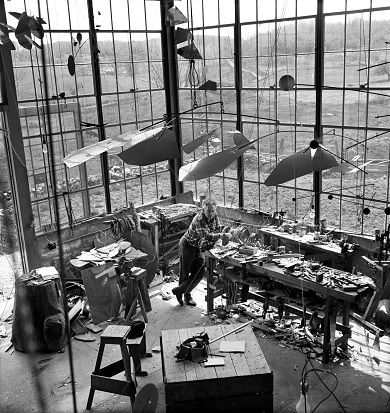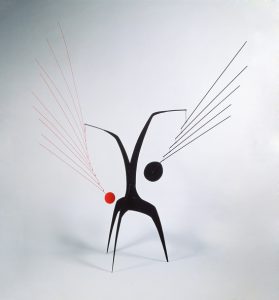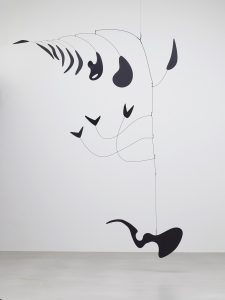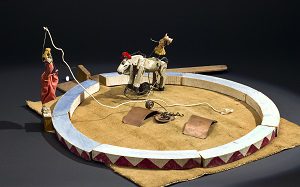Alexander Calder and the Optimism of Modernism: Jed Perl in Conversation with Morgan Meis

Calder with Mobile in his Roxbury studio, 1941 © 2017 Calder Foundation, New York / Artists Rights Society (ARS), New York Photography Credit: Herbert Matter
Morgan Meis Jed, I would have bet a fair amount of money that a Calder biography had already been written. Why has it taken so long?
Jed Perl In the 1950s Calder was friends with a man named William Rogers and talked to him about his writing a book on Calder. Rogers did write the book, but when Calder and his wife saw the typescript they were not pleased. It was very anecdotal, full of stories about Calder and his friends. They rejected it and it was never published. This started a tradition, I think, in the Calder family of being somewhat skeptical about biographies.
As his fame grew, Calder and his family were thrilled by his popularity. But after his death in 1976, the family started to feel that his true position as a pioneer, as an avant- gardist, the sense of the mobile as a great modernist invention was getting lost in the view of Calder as the American amuser, the man with the circus. So I think there was a hesitation about a biography. Would it put too much focus on his ebullient, always upbeat personality and not enough on his work? I think their main objective was to bring to the fore a sense of who he had been in the 30s and 40s, how radical his work had been, how serious and sometimes even sober it was. There had to be a sense of that before they were willing to go ahead with a project like this biography.
Morgan Meis Okay, but that background leaves me a bit surprised that you would write a biography about Calder. In your 2005 book New Art City, you use phrases like ‘the seriousness of the Abstract Expressionists.’ To me, Calder represents something playful and perhaps even a little bit frivolous. Having read the first volume of the biography, obviously this is not your take on Calder at all. Can you say a little bit more about how he should be viewed?
Jed Perl Well, three or four things come to mind. There is tremendous wit in Calder’s work, but also a sharp, clear, hard intelligence behind it. For all the playfulness of a mobile there is a sense of something calculated and engineered and sharply thought through that fuels that kind of play.
Alexander Calder Un effet du japonais, 1941 © 2017 Calder Foundation, New York / Artists Rights Society (ARS), New York
That really interests me. I wrote a little book, Antoine’s Alphabet, about Watteau, another artist who is often thought of as playful and sort of ‘surface-y.’ One of the things that interested me there was the acuteness of attention and insight that underpinned that lightness. I have always been interested in “the iron fist in the velvet glove.” I think there is a quality of that about Calder.
There are also some larger things that come to life in a biography that excited me here. I have always been fascinated by New York’s art world and, as well, the Parisian art world (which I wrote about in my first book, Paris Without End). Calder of course is someone who at various points spans both worlds. That interested me, that trans-Atlantic story.
I was also interested, as someone who has been a part of this crazy art world for over thirty years, about how serious work – the kind of vanguard vision that Calder was involved with – how that can (or cannot) gain in popularity. In our celebrity-obsessed society can the authentic individual voice to be heard? How can that happen?
Until the late 60’s and even the early 70’s—I will be discussing this in Volume 2 of the biography–large-scale abstract sculpture in public places was practically unheard of in America. I think it was seen as too individualistic—crazily individualistic. When there was talk of putting a Calder outside at Lincoln Centre in the early 60’s there was a whole question as to whether it was going to be permitted. The head of the New York Park Commission, which controlled the spaces outside Lincoln Centre, a man by the name of Newbold Morris, was dead set against abstract sculpture. In 1969 when Calder did a huge piece for Grand Rapids, the reason he was so excited was that here was a fairly large mid-Western city that was actually interested in having a big abstract work! In the 70’s this all changed very dramatically. So Calder is part of the story of the ever-greater acceptance of modernism–and that interests me.
Finally, simply as a biographical subject, Calder is a very rich story–because of all the friendships, the different scenes and places and moments with which he was engaged. There are artists that I adore – Morandi for instance – but I can’t imagine writing a biography of Morandi because he lived this very quiet life.
Morgan Meis There is no story there!
Jed Perl Right! So the Calder story is, in that sense, a real blessing.
MM That prompts a thought: Is there then a kind of ‘Trojan horse’ characteristic to Calder for you, something about the delightfulness of the work that allows him to smuggle in some of the serious stuff of high modernism and abstraction into sculpture where it might not otherwise have been accepted?
JP That’s a really interesting way of putting it. Calder, for all his unabashed openness and gift for friendships, was in some ways an elusive figure. One of the things it took me a long time to work through was how to take things he said. Both his parents were artists. His father was this kind of philosophizing, somewhat depressive figure and he grew up with his parents always talking about art and form and colour, having all these aesthetic conversations. Part of the reason he was disinclined, at many points later in his life, to offer disquisitions on his work was that it reminded him of what he hated when he was growing up.
So his statements about his work—even his demeanor about his work–can be somewhat confusing. Sometimes he said completely wacko things. An example comes from a time when he was having a show at the Tate in London, I think in the 60’s. He was living in France at the time – and one of the London newspaper reporters came over to interview him. He said something like—I’m paraphrasing– “Mr Calder, what are you going to in London?” Calder replied, “Well, I am just going to make sure the mobiles are not bumping into each other and then I’ll go home”. You think geez—how silly! But then there are times he can be incredibly thoughtful. As when he talked about being fascinated by the abstract forms of the circus tent when he was in his 20s. He said that to a painter—a very intelligent painter–who was interviewing him.
So, a lot of what he said or didn’t say depended on who he was talking to. In his later years, when he was extraordinarily famous, he had visitors who knew nothing about the history of modernism or abstract art–and he just didn’t have the heart or the energy or the inclination to sit down and explain the whole thing to them. So he would say any old thing. And if people were amused, that was fine with him. He was once asked something like “What do you do when you get stuck and don’t know what to do next?” He replied that he reread the brief essay that Jean-Paul Sartre had written about him, which is one of the most brilliant texts ever dedicated to a modern artist. He said that reading Sartre—or another brilliant critic, James Johnson Sweeney—helped him to get going again. So Calder was a complicated mixture of profound seriousness and an easiness that could sometimes strike people as flippant.
MM Yes, reading the book Calder sometimes comes across as a bridging figure, talking one way to one group but another way to another group, sometimes serious and sometimes less so, sometimes coming cross as more European, sometimes more American. You write about how you can look at his work from a strict formalist viewpoint but you also argue that he was interested in the merger of all the arts, what Wagner called the Gesamtkunstwerk. To what extent do you think that he consciously set out to be a man who bridged different groups, sensibilities, and approaches to art?
JP I think he was a man of different impulses, a man with a rich and varied personality. Part of my point in the early parts of the book is that his parents were in a sense modernists. They were interested in the same ideas about the unity of the arts that had influenced thinking in places like the Bauhaus. From childhood, Calder had a very strong sense of both the core modernist values and the variety and range of modernist possibilities. Calder never lost that sense of multiplying possibilities. Today is a dark time in many respects, in the art world as everywhere else; we feel like a lot hopes have been shattered. Sometimes it‘s hard to grasp the tremendous core of optimism that Calder had and shared with his modernist cohort – Mondrian, Miró, Duchamp and so many others.
That optimism helps explain why Calder was unperturbed by sometimes being misunderstood. Modernists were misunderstood. But he always had this core of friendships, of people who were on the same wavelength, so whether he was doing a big theatrical thing or an intimate table scale mobile or book illustrations, he was moving among people who were all on this wavelength. He was very much a family man and in a sense he lived his whole creative life among an extended family. That gave him that core that meant he could go off and do various things; he didn’t feel he would be diminished if he designed a textile or painted an airplane, as he did late in life.
In the second half of his career, when huge commissions were coming his way, there was almost invariably some really interesting artistic spirit involved—somebody who was on Calder’s wavelength. For example, Calder went down and did a huge sculpture for the ’68 Olympics in Mexico City. There was a man named Mathias Goeritz, a fascinating figure, born in Germany, an anti- Nazi who left there in his 20’s and through all kinds of adventures ended up in Mexico. It’s this man who brought Calder to Mexico City and made the whole Olympic thing happen. So there was this network and the thing I have realised – including from talking to Calder’s family – is that these people, some living in America, some in France, really felt they were part of an international community. They had roots in different places but there was a sense of a large modern mission that transcended borders. This is why, during World War II, when so many emigres arrived from Europe – artists, writers – the Calders were the go-to people even for those they didn’t already know. I’m thinking of people like Saul Steinberg, the cartoonist. They didn’t know him in Europe but he makes his way to America and he’s friends with them almost immediately, because they are all part of this international brotherhood and sisterhood which is dedicated to art and ideas. It’s very moving, really.
MM So all the rich material of his life, his family and these different cultures, it’s such a rich content. Are you saying that he abstracted directly from this into his art?
JP Well, I think I say it toward the end of the book: a mobile is a family of forms. Calder gave a mobile to Ben Nicholson and Barbara Hepworth and said that each element in the mobile was literally a member of the family.
Alexander Calder Eucalyptus, 1940 © 2017 Calder Foundation, New York / Artists Rights Society (ARS), New York Photo: Calder Foundation
In a larger metaphoric sense that is part of what mobiles are about. The Calders loved dancing. On New Year’s Eve, the Calders would entertain their friends at their house in Roxbury, Connecticut, and they would all still be dancing wildly in the early hours. You can see the connection between that social dancing and the idea of a mobile. Mobiles are about a sense of community, a sense of connectedness, the relations between people, the way parts go together. Among many other things, Calder’s art is an abstraction of some of the feelings and emotions that were so important in his life.
MM This also helps to explain why his art has a liveliness, literally the movement in his work versus other modernist abstraction from that time that was static.
JP Well up until the 60’s people going into galleries were allowed to push and manipulate Calder’s work. Calder very definitely conceived many smaller and sometimes even medium-sized works as objects for domestic environments, where people would bump into them, push them in different ways. Depending on the number of elements, the weight of the wire, the nature of the connections, mobiles move in very different ways. I didn’t really understand this until I saw many different mobiles in motion, often at the Calder Foundation. Calder designed a controlled form of movement, one which often gives the viewer an element of choice as to how the mobile will actually move, so there is an interaction between the artist and the viewer.
Of course viewers always engage with a work of art. You do that when you scan the surface of a painting or move around a sculpture. But Calder engages the viewer in new and different ways. It’s not as if the viewer is making or re-making the work. The work is very specific; Calder controls things, but he also allows for an element of openness. I suppose that reflects an attitude toward life—a philosophic attitude, if you will.
MM Toward the end of the book you say outright that Calder achieved a new kind of classical style.
JP Yes. There is always a question in the arts about the ideal balance between freedom and control. If a work is overly controlled, we may feel that it’s academic. If the artist hasn’t exerted enough control over the material, we may find the work incoherent. Calder was looking for a new balance between what the poet Apollinaire referred to as the never-ending struggle between order and adventure. The motor driven works – most of which are from the 30’s and which he largely abandoned later on – they move very slowly and I think his idea was that they might function as objects of contemplation. But I think he also found that the movement was almost too regular –
MM Almost too much of a giving over to the machine?
JP Yes. Exactly. I think that helps to explain why he began gravitating in the mid-1930s from motor-driven to wind-driven mobiles. But one of the things that I love about Calder is that nothing is ever entirely set aside. There are a certain number of motor-driven mobiles from his later years. And although he largely stopped doing the wire figure sculptures, all of a sudden, in the 60’s he does a wire portrait of his friend the Italian art critic Giovanni Carandente. Certain images and ideas return to the work decades after they disappear. Calder did a series of very witty figures called “Critters” in the 70’s – they’re among the last works shown in New York and Paris – and they may represent a reconsideration of some of the ideas from his pre-abstract work. So there was a sense with him that nothing should ever be completely abandoned. The austere style of the first abstract works of the early 1930s returns from time to time. Some people might call this inconsistency, a lack of a stylistic trajectory. To me it reflects a wonderful human richness. We all have different moods, different ways of feeling, and his work reflects that.
MM Yes, you say somewhere in the book “he wanted to be clear and unfussy, to get straight to the point. At the same time, he liked to linger over life’s oddities and obscurities.”
JP Yes. That sometimes makes it a challenge to deal with his work, because there can be so many things going on, even in a relatively brief period of time.
MM But I still get the sense that for you all these oddities and obscurities have to be there—that they’re somehow related to Calder’s greatness.
JP Absolutely. One of the things I find somewhat disappointing about the Abstract Expressionists is how limited their imagery can become. Much of their peak work was done in a very brief period, in the late 40’s and early 50’s. Rothko was doing these very rich paintings with surprising colour orchestrations and a variety of different forms. But as time went on his work, at least to my way of seeing, became narrower and narrower. The same thing happens with de Kooning; his repertory doesn’t grow, at least to my way of seeing.
One of the things I love about Mondrian is the surprise of the Boogie Woogie paintings at the end of his life. After the extreme austerity of his late 20’s paintings he starts to complicate things again and he ends up doing paintings that almost violate the rules that he himself had set up. Maybe it’s just my own emotional makeup, but I like an artist who is full of surprises – who’s capable of backing up and heading in a different direction. You see this in Matisse. After the simplified works of the mid-teens, he goes back to the figure and works directly from life. Years later he is working practically at the brink of abstraction. This kind of back and forth shows a real human variety.
MM That gives me a better sense then of why you wanted to do a biography. You have to portray the person in their full dimension as a full human being. You can’t extract the art directly from the life—it’s not that the life explains the art in some silly one-to-one correspondence—but you are searching for a full, rich human being here.
JP Absolutely. One of the things that occurred to me only after I’d been working on the book for a few years was that there was a connection between the very austere abstract work of the early 30’s and the times out of which they emerged. No one had thought to think about them in relation to the Great Depression. But imagine Calder doing those comic Josephine Baker things in 1933 – he would have seemed like a person in denial, like someone still drinking after the party is over.
Of course the relation between the art and the life is a very complicated thing. The great thing about a biography is that it gives you so many opportunities to see how the various strands of the art and the life intersect over a period of time
MM Let’s go back to his circus works for a moment. There is an element of those works that never goes away. There is something pre-modern, ancient – almost like a shaman, a magician – that is always lingering. Is there something important about this work, even as he is producing abstractions, that are a part of high modernism?
Alexander Calder Equestrian act from Cirque Calder (1926–31) © 2017 Calder Foundation, New York / Artists Rights Society (ARS), New York Photography Credit: Sheldan C. Collins
JP Well some would argue that those ideas are a part of high modernism – the sense that the artist is not a recorder of actuality but a mystic, a magician who is in touch with the unconscious, with dreams, with the mysteries of the cosmos.
MM I am thinking more of Clement Greenberg’s version of modernism
JP Greenberg’s version of modernism—the sense of modernism as involving a purification of the arts–was of course only one version of modernism. My sense is that even some of the artists Greenberg most admired rejected his views. The Abstract Expressionists were certainly a good deal more interested in the mystical and magical than Greenberg cared to acknowledge. Greenberg wasn’t a fan of Calder’s work. There are many reasons for that, but one may have been that Greenberg sensed in Calder an affinity for the magical, for the uncanny, for the ritualistic. That was what the Surrealists admired in Calder, although he probably found their ideas as programmatic as he would have found Greenberg’s. If you had said to Calder over dinner, ‘You like to be a magician,’ he probably would have rolled his eyes and looked the other way. That doesn’t mean it wasn’t true!
Calder’s vision of modernism has a pluralistic power that is very much related to the times and places where he came of age. When Calder lived in Paris in the late 20’s and early 30’s all sorts of ideas were in play. There is no question in my mind that the evolution of the mobile—which takes sculpture into the realm of time—was influenced in some way by all the discussions about the fourth dimension that went on in bohemian circles in those years. Calder was, so I believe, also much influenced by the fascination with the Ballets Russes and various other ballet companies at the time. Which brings us back to the whole question of the Cirque Calder, which like the Ballets Russes is rooted in some very ancient ideas about the power of the theater.
MM And yet at the same time Calder was interested in working with some modern industrial materials.
JP Well, yes, in the sense that metal and wire are modern materials. But of course they are also very ancient materials. In any event, there is very definitely in Calder’s work a fascination with metamorphosis that goes back to the ancients, an interest in animating the inanimate. You feel that in Calder’s work. So why didn’t Calder talk about these things very much, if at all? That’s a big question. I’ll say just one thing. At any given time, there are certain ideas that are so ubiquitous, so much “in the air,” that you don’t really need to talk about them.
MM This makes me wonder if your biographical project might be, among many other things, a way of recovering certain ideas and attitudes that have been eclipsed, if not lost entirely?
JP Yes. I’m very interested in establishing the context, in what a friend of mine who wrote to me about the book referred to as ‘cultural memory.’ You want to bring those memories to life, but you also don’t want them to swamp the work! This is the challenge of a biography like this. You simultaneously want to have the context with all these things ‘in the air.’ But at the same time you want to preserve the freshness, immediacy and uniqueness of the work of art. As a writer one tries to maintain that balance.
MM The travails of a writer! That’s a good place to end. Thank you for such an interesting conversation.
JP Thank you for making the occasion.
“Calder: The Conquest of Time: The Early Years: 1898-1940″ by Jed Perl is published by Alfred A Knopf



